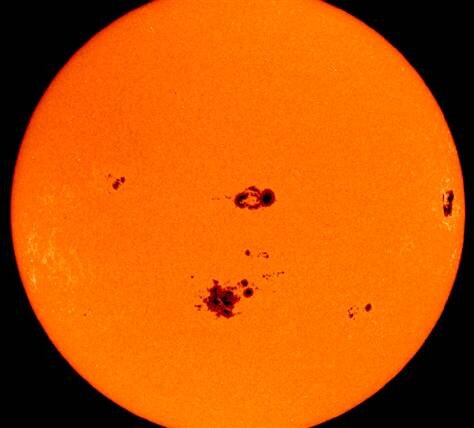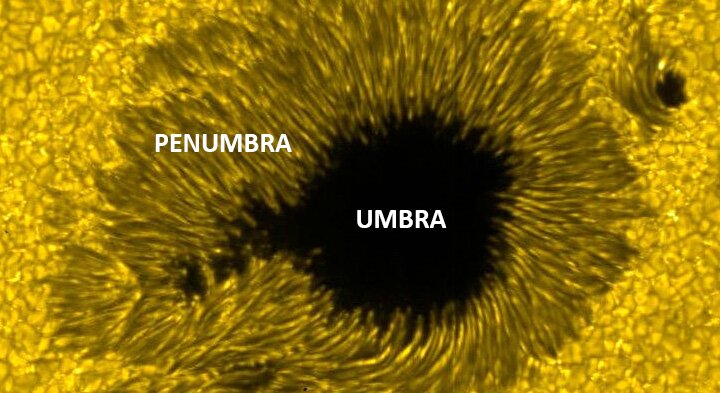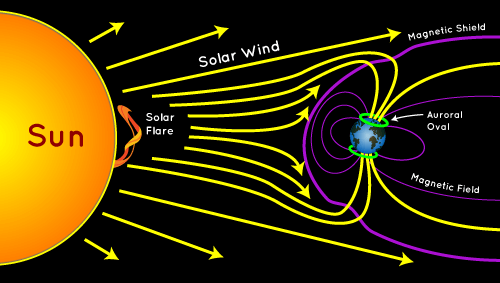Sunspots
Why in News
A massive Sunspot group ‘AR2770’, which was detected recently, has emitted minor space flares.
- These flares have not caused any major impact on the Earth. However, these have led to minor waves of ionization to ripple through the Earth’s upper atmosphere.
Key Points
- Sunspots:
- Sunspots (some as large as 50,000 km in diameter) are areas that appear dark on the surface of the Sun (photosphere). They appear dark because they are cooler than other parts of the Sun’s surface.
- However, the temperature of a sunspot is still very hot —around 6,500 degrees Fahrenheit.
- Photosphere is a visible surface of the Sun, from which is emitted most of the Sun’s light that reaches Earth directly.
- They are relatively cool because they form at areas where magnetic fields are particularly strong. These magnetic fields are so strong that they keep some of the heat within the Sun from reaching the surface.

- Magnetic field in such areas is about 2,500 times stronger than Earth’s.
- They typically consist of a dark region called the ‘umbra’, which is surrounded by a lighter region called the ‘penumbra’.
- In every solar cycle, the number of Sunspots increases and decreases.
- The current solar cycle, which began in 2008, is in its ‘solar minimum’ phase, when the number of Sunspots and solar flares is at a routine low.
- Sunspots (some as large as 50,000 km in diameter) are areas that appear dark on the surface of the Sun (photosphere). They appear dark because they are cooler than other parts of the Sun’s surface.
- Solar Flares:
- The magnetic field lines near sunspots often tangle, cross, and reorganize. This can cause a sudden explosion of energy called a solar flare.
- The solar flare explosion’s energy can be equivalent to a trillion ‘Little boy’ atomic bombs dropped on Hiroshima and Nagasaki in 1945.
- Solar flares release a lot of radiation into space. Solar flares, when powerful enough, can disrupt satellite and radio transmission on the Earth, and more severe ones can cause ‘geomagnetic storms’ that can damage transformers in power grids.
- A geomagnetic storm is a major disturbance of Earth’s magnetosphere that occurs when there is a very efficient exchange of energy from the solar wind into the space surrounding Earth.
- Magnetosphere is a region around the Earth dominated by the Earth’s magnetic field.
- It protects the Earth from solar and cosmic radiation as well as erosion of the atmosphere by the solar wind - the constant flow of charged particles streaming off the Sun.
- A geomagnetic storm is a major disturbance of Earth’s magnetosphere that occurs when there is a very efficient exchange of energy from the solar wind into the space surrounding Earth.
- Solar flares are sometimes accompanied by a Coronal Mass Ejection (CME).
- CMEs are huge bubbles of radiation and particles from the Sun’s Corona (outermost region of the Sun’s atmosphere). They explode into space at very high speed when the Sun’s magnetic field lines suddenly reorganize.
- They can trigger intense light in the sky on Earth, called auroras.
- Some of the energy and small particles travel down the magnetic field lines at the north and south poles into Earth’s atmosphere.
- There, the particles interact with gases in the atmosphere resulting in beautiful displays of light in the sky. Oxygen gives off green and red light. Nitrogen glows blue and purple.
- The aurora in Earth’s northern atmosphere is called an aurora borealis or northern lights. It’s southern counterpart is called an aurora australis or the southern lights.
Solar Cycle
- The Sun is a huge ball of electrically-charged hot gas. This charged gas moves, generating a powerful magnetic field. The Sun's magnetic field goes through a cycle, called the solar cycle.
- Every 11 years or so, the Sun's magnetic field completely flips. This means that the Sun's north and south poles switch places. Then it takes about another 11 years for the Sun’s north and south poles to flip back again.
- The solar cycle affects activity on the surface of the Sun, such as sunspots which are caused by the Sun's magnetic fields. As the magnetic fields change, so does the amount of activity on the Sun's surface.
- One way to track the solar cycle is by counting the number of sunspots. The beginning of a solar cycle is a solar minimum, or when the Sun has the least sunspots. Over time, solar activity—and the number of sunspots—increases.
- The middle of the solar cycle is the solar maximum, or when the Sun has the most sunspots. As the cycle ends, it fades back to the solar minimum and then a new cycle begins.
